Last month, Nickelodeon and IDW Games teamed up to create The Legend of Korra: Pro-Bending Arena, bringing the fast-paced bending tournaments from Season 1 of the show to your tabletop. I mentioned the Kickstarter campaign when it launched, but I hadn’t been able to get a prototype to play. I did get one to try out after the campaign ended, so I’m going to flesh out the gameplay and talk about some of the things that were revealed during the course of the campaign.
Although the Kickstarter campaign has ended, there’s still time until the end of this week (October 20) to put in a late pledge. If you’re interested in pledging, you’ll need to contact IDW Games through Kickstarter (using the “contact me” function on this page) and send them your full name and email address.
What Is The Legend of Korra: Pro-Bending Arena?
The Legend of Korra: Pro-Bending Arena is a game for 2 players, ages 12 and up, and takes 30–45 minutes to play. The deluxe edition through Kickstarter is $65, with the Amon Invasion expansion available as a $30 add-on. Thematically I think the game is fine for any kid who is old enough to watch the show that it’s based on; the gameplay itself isn’t too difficult to pick up.
New to Kickstarter? Check out our crowdfunding primer, and visit our Kickstarter curated page for more projects we love.

The Legend of Korra: Pro-Bending Arena Components
The prototype set only includes two teams, the Fire Ferrets and the Wolfbats, along with the base set of 18 Trick cards and the primary components. (It also uses a 6-card referee deck instead of a referee die.) This might be what is eventually included in the retail edition, though it was not completely clear to me if that’s the case. The Kickstarter page mentions that the deluxe edition is only available through Kickstarter, and the deluxe edition includes seven more teams, and five more sets of tricks. Unfortunately the 3D-printed miniatures in the prototype didn’t all survive the trip; I was able to glue some of them back together, but Tanho just isn’t recuperating well.
You can see the entire list of components on the Kickstarter page, but here’s a rough breakdown of what you get:
- 1 game board
- 1 Referee die
- Fire Ferrets:
- 3 Fire Ferret miniatures
- 36 Fire Ferret technique cards
- 1 Fire Ferret team board
- Wolfbats:
- 3 Wolfbat miniatures
- 36 Wolfbat technique cards
- 1 Wolfbat team board
- Rabaroos:
- 3 Rabaroo miniatures
- 36 Rabaroo technique cards
- 1 Rabaroo team board
- 6 Universal Trick cards
- Boar-Q-Pines:
- 3 Boar-Q-Pine miniatures
- 36 Boar-Q-Pine technique cards
- 1 Boar-Q-Pine team board
- 6 Universal Trick cards
- Red Lotus:
- 1 P’Li miniature
- A deck of P’Li technique cards
- 1 Red Lotus team board
- 3 P’Li Trick cards
- 3 Opponent Trick cards
- Tigerdillos:
- 3 Tigerdillos miniatures
- 36 Tigerdillos technique cards
- 1 Tigerdillos team board
- 6 Universal Trick cards
- Buzzard Wasps:
- 3 Buzzard Wasps miniatures
- 36 Buzzard Wasps technique cards
- 1 Buzzard Wasps team board
- 6 Universal Trick cards
- Earth Empire:
- 1 Kuvira miniature
- A deck of Kuvira technique cards
- 1 Earth Empire team board
- 3 Kuvira Trick cards
- 3 Opponent Trick cards
- Water Tribe:
- 1 Unalaq miniature
- A deck of Unalaq technique cards
- 1 Water Tribe team board
- 3 Unalaq Trick cards
- 3 Opponent Trick cards
- 6 Daze tokens
- 12 Hold tokens
- 6 Yellow Fan tokens
- 1 Momentum token
- 2 Chi markers
- 30 Element tokens (10 each Fire, Earth, Water)
- 48 Trick cards – 18 in base set, and 6 each in 5 additional sets
- 6 Base clips (2 each Fire, Earth, Water)
There are three “teams” that only have one character each: Red Lotus, Earth Empire, and Water Tribe. In those cases, the Kickstarter campaign did not specify how many technique cards were included. Otherwise, each team comes with miniatures for the characters, a player board, and 6 new tricks (three per team).
The Amon Invasion expansion set includes:
- 5 miniatures
- 1 dual-sided Amon board
- 1 Korra Avatar board
- 1 A.I. deck
- 1 Amon technique deck
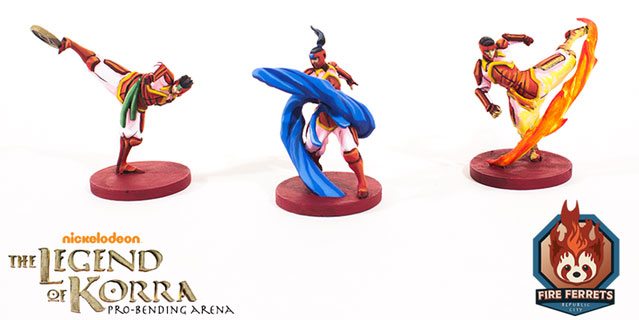
You can see a lot more pictures of the components on the Kickstarter page, but the miniatures look really great. Yours won’t come painted, of course, but the dynamic poses are fantastic.
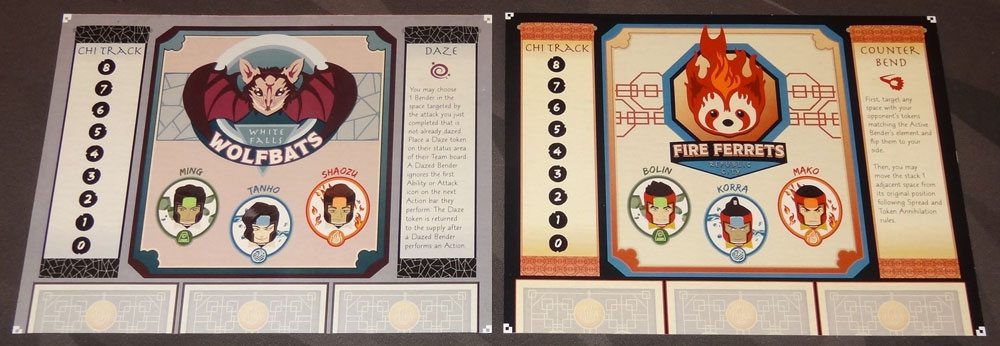
and show your special team ability. (Prototype shown) Photo: Jonathan H. Liu
I also really like the artwork for the teams, both for the team logos and the bender portraits on the boards. They look like something that would fit within Korra’s world, and help to immerse you in the game.
How to Play The Legend of Korra: Pro-Bending Arena
The Goal
The goal of the game is to knock all of your opponent’s benders off the arena board, or to be further forward in the arena when time is called. If neither team has advanced when time is called, the team with the momentum token wins.

Setup
Set the board in the center of the table, with the element tokens, yellow fans, hold tokens, and referee die next to it.
Each player takes one team and all associated components. The benders are placed in your own Zone A, the closest to the center, in any of the spaces. The starting player will get 2 chi (marked on the team board) and the second player gets 3 chi.
Find your 6 basic technique cards—there are 2 per bender and they have a 0 cost. These are shuffled and form your starting deck. You also build three bender decks using the rest of your technique cards: each bender gets a deck of 4 cards. (For beginners, use one of each card type; for advanced players, you may mix and match from your available cards.) These are set face-down near your player board, and the first three cards are turned face-up, forming your strategy row. Then, draw three cards from your starting deck.
Gameplay
Each turn has four phases: Keep Focused! Play Hard! Check Hits! Stay Sharp!
Keep Focused!
Get 1 chi. (This step is easy.)

Play Hard!
This is the main play step. You will play all three of your cards in the order you choose. For each card, you either use it for its technique, or gain 1 chi.
Each card shows a number of actions on it—if you play the card, your corresponding bender must do all of the actions on the card, in the order shown. Actions may include:
- Move: move one space within your current zone
- Block: remove a number of your opponent’s elements in your space
- Normal attack: place a number of tokens of your element in a space within the attack’s range. Tokens will first cancel out an opponent’s tokens, and then any remainder will stay in the space. Note: you may not place tokens in your bender’s own space, nor in any spaces that already have tokens of that element.
- Piercing attack: like normal attack, except that tokens do not cancel each other out.
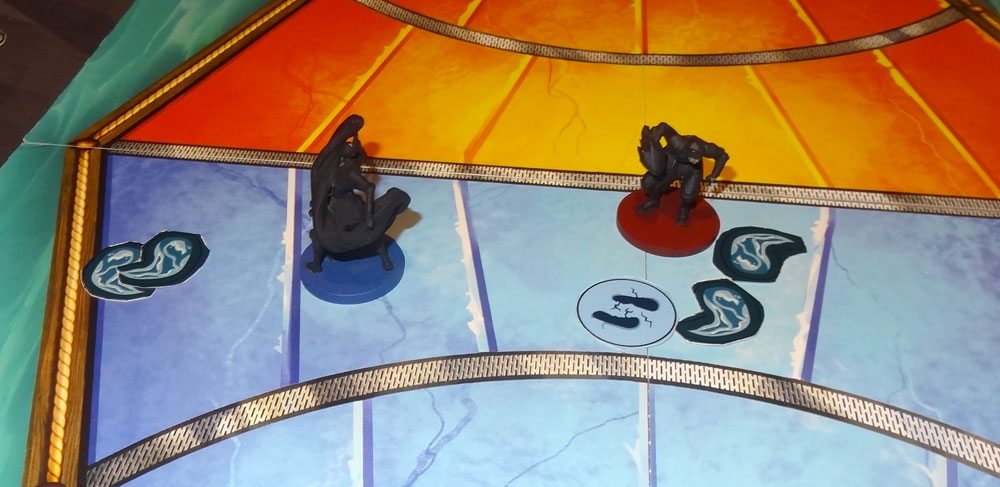
Some attacks have modifiers:
- Hold: place a hold token in the target space; each hold token cancels out one move action from that space.
- Follow-up: place additional element tokens in an adjacent space.
- Yellow fan: roll the referee die to see if your bender gets a yellow fan (foul); if your bender get 2 yellow fans, it is ejected from the game.
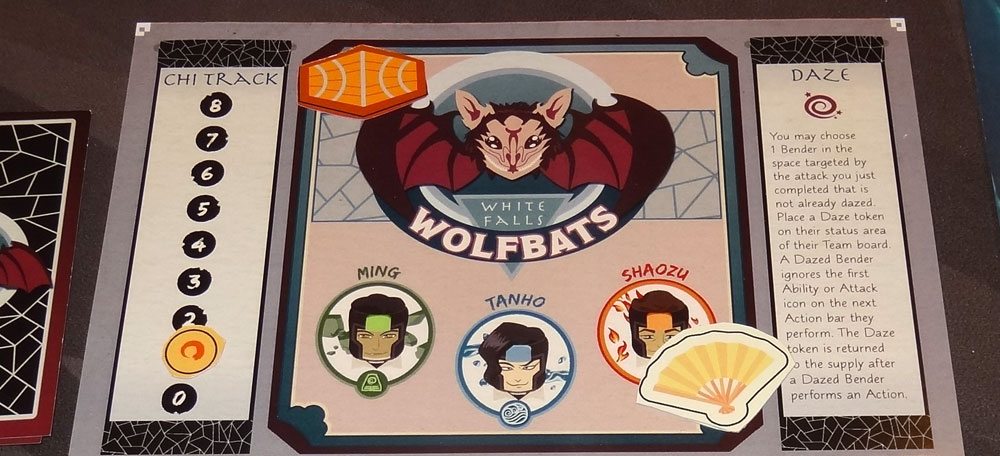
Each team also has a unique ability that appears on their player board. For instance, the Fire Ferrets can counter bend, turning an opponent’s element tokens into their own. The Wolfbats can daze a bender, canceling out the first action on a technique card.
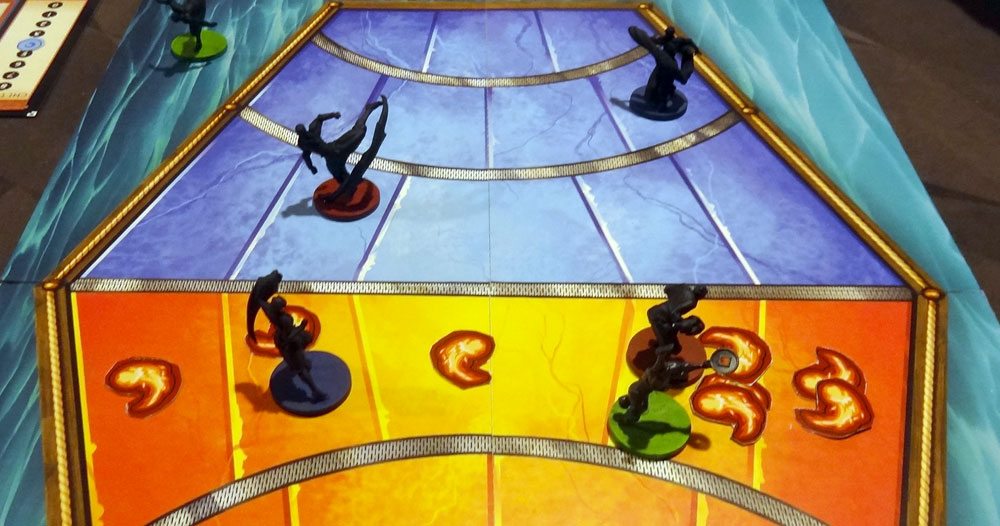
Check Hits!
After playing all three of your cards, check each of your bender’s spaces. For each of your opponent’s element tokens in your bender’s space, that bender is knocked back that many zones. (If you have multiple benders in the same space, they each suffer the total number of hits.) After hits are resolved, remove all of your opponent’s tokens from the board.
If your bender gets knocked out (off the end of the board), you earn 2 chi, and then remove that bender’s strategy deck and cards from strategy row (but not from your main deck or discard pile). Your opponent gets the momentum token.
If all three of your benders are now out of the game, your opponent wins.
If, after resolving hits, there is an entirely empty zone between you and your opponent’s closest bender, your opponent gets a line advance. First, the opponent moves all of their benders into the zone closest to you, and takes the momentum token. Then, you may move your benders to any space within the same zone. Finally, you get an extra turn, and then play passes to your opponent.
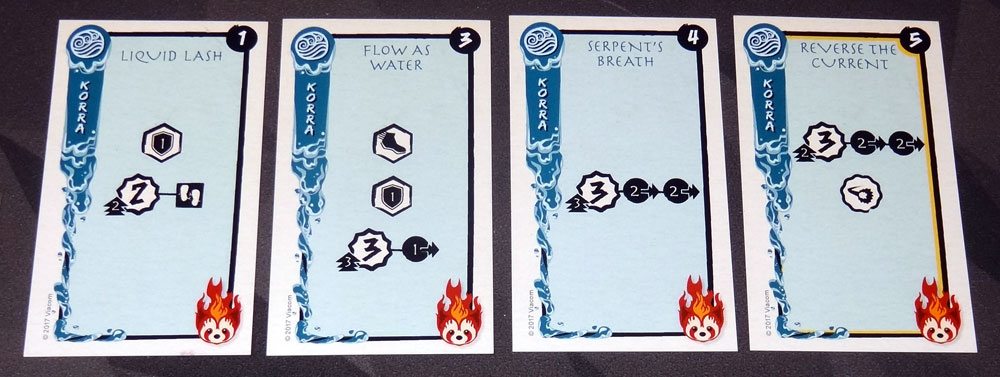
Stay Sharp!
Spend chi to add face-up technique cards from your strategy row—they are placed on top of your deck. Then, add one technique from one of your strategy decks face-up to the row (potentially covering up other cards there). Finally, draw a new hand of 3 cards. When you run out of cards, you may first remove one card from your discard pile from the game before reshuffling it to form a new deck.
If you ever need to add a card to your strategy row and all of your strategy decks are empty, then roll the referee die. A yellow fan means the referee calls the end of the game:
- If you have at least one bender on your opponent’s side of the arena, you win.
- If neither team has advanced, the player with the most benders wins.
- If it’s still a tie, the player with the momentum token wins.
Advanced Play
Advanced play includes three things: custom strategy decks, tricks, and fantasy team building.
You can customize the strategy decks (as I mentioned for setup) by choosing which cards to include in each bender’s deck.

Tricks are additional powerful moves that are tied to a specific bender. Each team gets a stack of the same tricks to choose from, and you may pick three tricks to use for the game. You may choose one per bender, or you may let a bender have more than one trick. When you play a technique card for actions, you may then activate a trick—some tricks have additional conditions that must be met.
Some tricks are discarded after use, and others force you to roll the referee die for a potential yellow fan. Tricks might amplify an element, adding more tokens to a space that already has that element; deflect elements, moving tokens from your bender’s space into an adjacent space; or put tokens into a space (ignoring usual placement rules).
If you have the additional teams, you can mix and match benders (as long as you have one of each) to create your own teams.
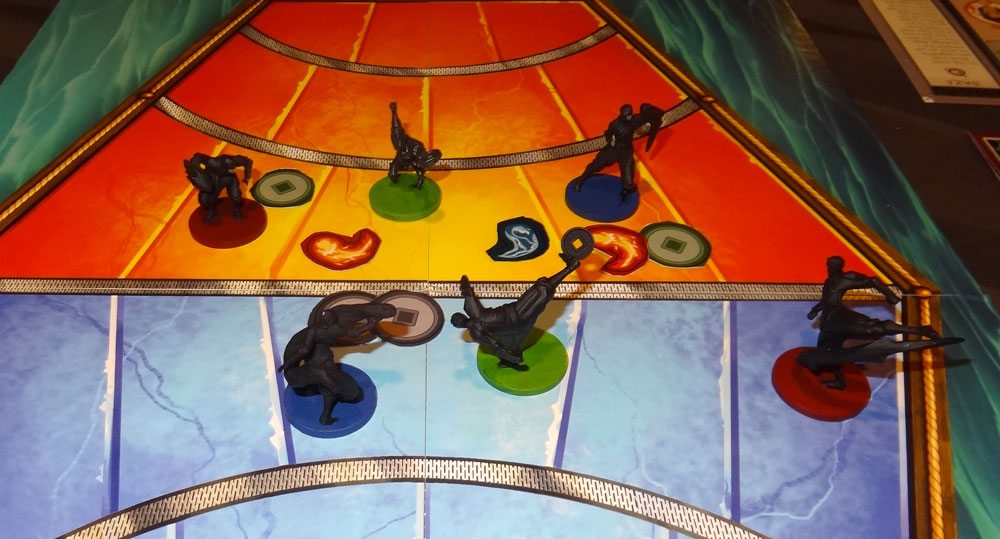
Why You Should Play The Legend of Korra: Pro-Bending Arena
My family was late to The Legend of Korra—we only started watching it together last year, but we’ve really been enjoying the story. The pro-bending portion of the story certainly lends itself well to a board game: there are defined rules for the sport, which then become the core rules of the game.
I’ve only been able to play the core set, with the Fire Ferrets vs. the Wolfbats, but there’s plenty to explore just in these two teams, even before you get to building your own strategy decks or adding in the tricks. With the entire set of nine teams and five extra sets of tricks, this is definitely a game that will give you plenty of replayability.
The flow of the game is fairly simple: play your cards, see if you get hit. Of course, what you do with each of the cards is what counts. Do you spend your cards for chi early on, hoping that you can make up for getting hit a few times by getting your advanced techniques early? Or do you lay down as many elements as you can, forcing your opponent to defend instead of attack? Paying attention to the placement rules—you can’t typically block elements with the same type—you may be able to trap your opponent so that they have no way to defend. Or, you place elements in adjacent spaces if you think they’ll have to move in order to attack you.
In pro-bending, you are always playing offense and defense at the same time. If there are elements in your bender’s space, you only have your current turn to deal with them, either by having another bender put some elements there to annihilate them, or by moving away. If you’re stuck in that space and you don’t have a bender to help? Well, looks like you’re getting knocked back. But if you’re spending all your elements to cancel out hits, it means that you aren’t targeting your opponent, either. It’s a tricky dance, figuring out how to keep your opponent on the defensive while avoiding the hits yourself.
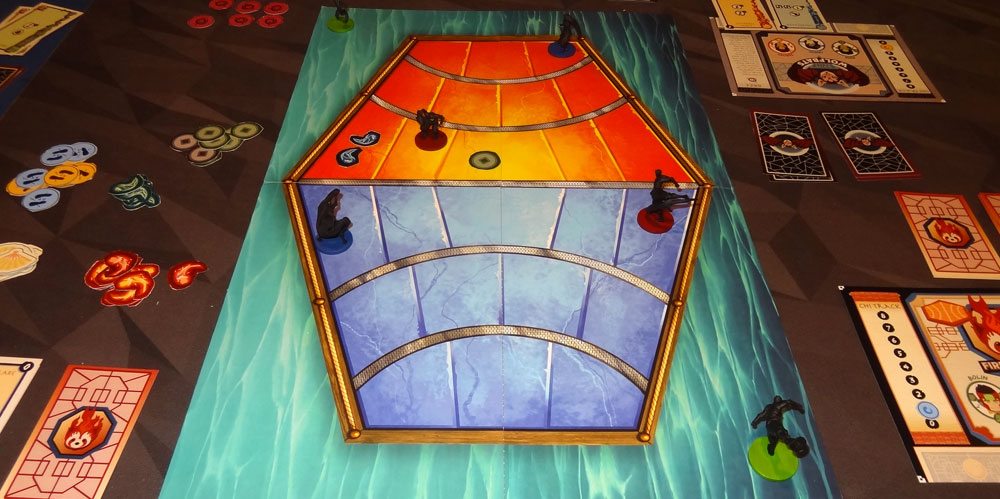
The advanced technique cards can be really powerful, of course, but you have to save up for them. You do earn one chi per turn, so if you survive, you’ll eventually build up enough to buy them, but if you forego actions, you can get them even sooner. Knowing when to make that trade-off can be really important.
I do like that there are some interesting catch-up mechanics, too. When you lose a bender, you immediately get 2 chi—that gives you a chance to buy cards for your remaining benders. When you draw a card of that bender, it can only be used for chi, so you may build up more quickly that way, too. The downside, of course, is that now you’re short an element, which makes it harder to defend, and those cards can take up valuable space in your hand.
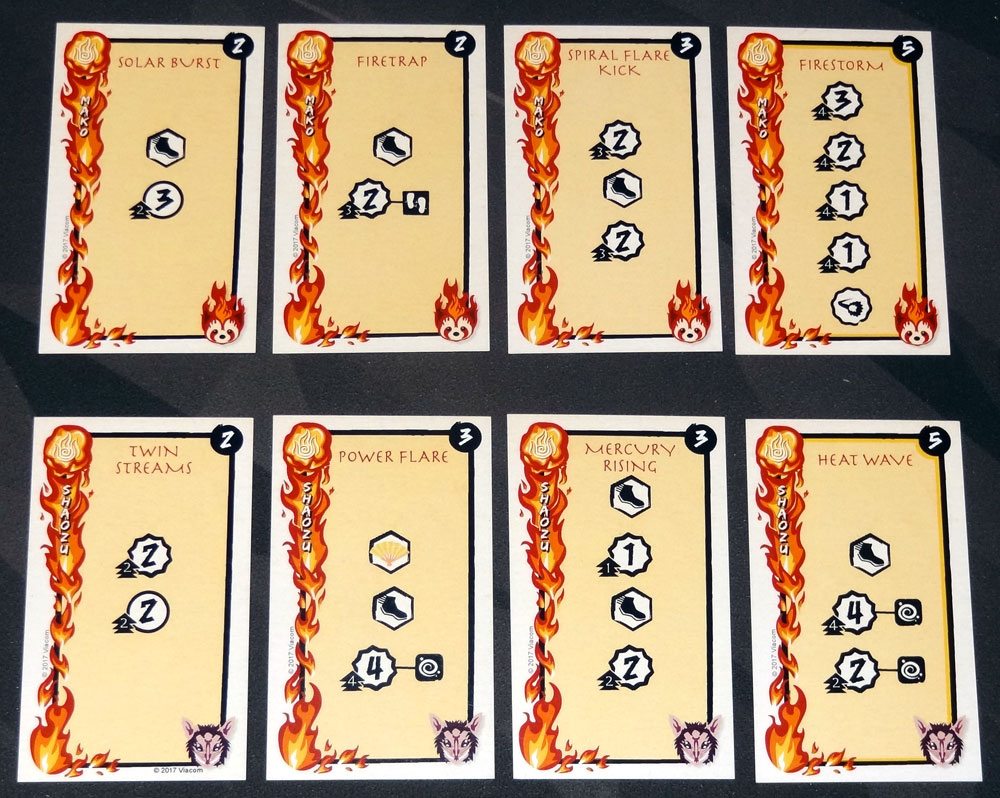
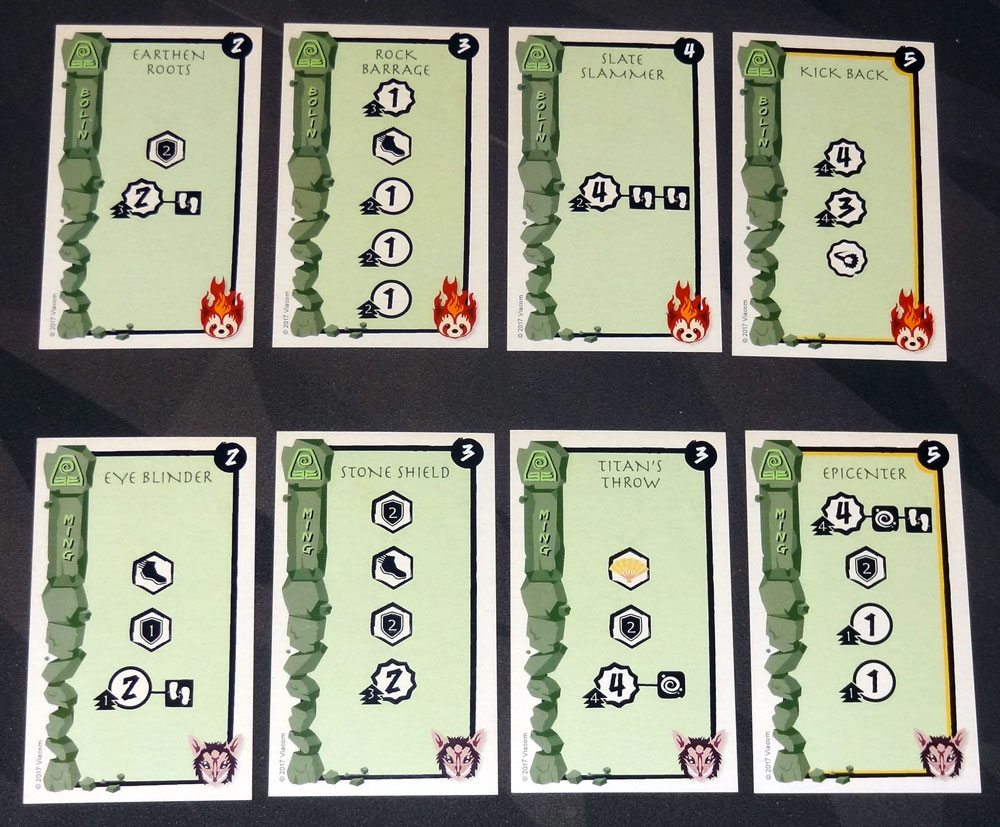
I also like the deck-building aspect of the game, which is twofold. First, you can set up the strategy decks for each bender at the start of the game. If you really like a particular card, you can put in multiple copies of that one, or you can diversify. Then, during the game, you can choose which benders to invest in first (though you don’t get to choose the order that the cards appear in the deck). Finally, every time you run through your deck, you can weed out one card, so that as you get more powerful cards for a bender, you can take out the starter cards. Again, you can try to power up one bender and make them really strong, but if that bender gets knocked out, then you’ll have spent a lot of chi on cards that can’t do anything for you, and your remaining benders will be at a loss.
The yellow fan mechanism is great—you can decide whether to risk a powerful move. The Wolfbats can daze players—as in the show, they’re prone to taking illegal head shots. It can be really effective in canceling out a move, but at the risk of getting thrown out of the game. I lost Shaozu in one game because he got caught too many times, but in another game the Wolfbats got away with a lot more treachery.
I do wish the game allowed more players, simply because I usually play games with more than just two players, but I’ve been able to play the prototype with my 10-year-old (who scored a surprise win even after I knocked Bolin into the water). I think Sen-Foong Lim and Jessey Wright, the designers, did an excellent job of bringing the various characters from the show to the tabletop, and I’m excited to see how the other teams play in the future.
If you’re interested in the deluxe edition, be sure to contact IDW Games through the Kickstarter page by October 20!
Click here to see all our tabletop game reviews.
Disclosure: GeekDad received a prototype copy of this game for review purposes.
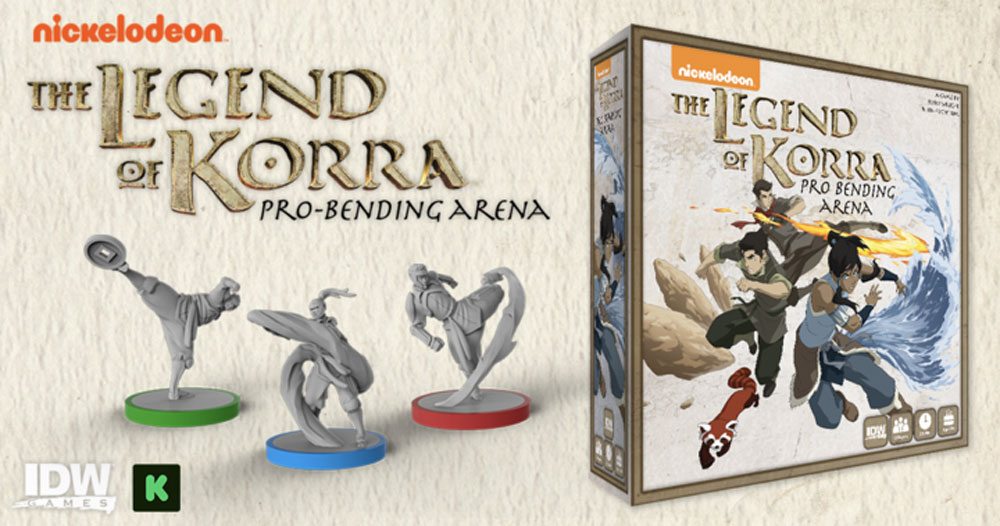


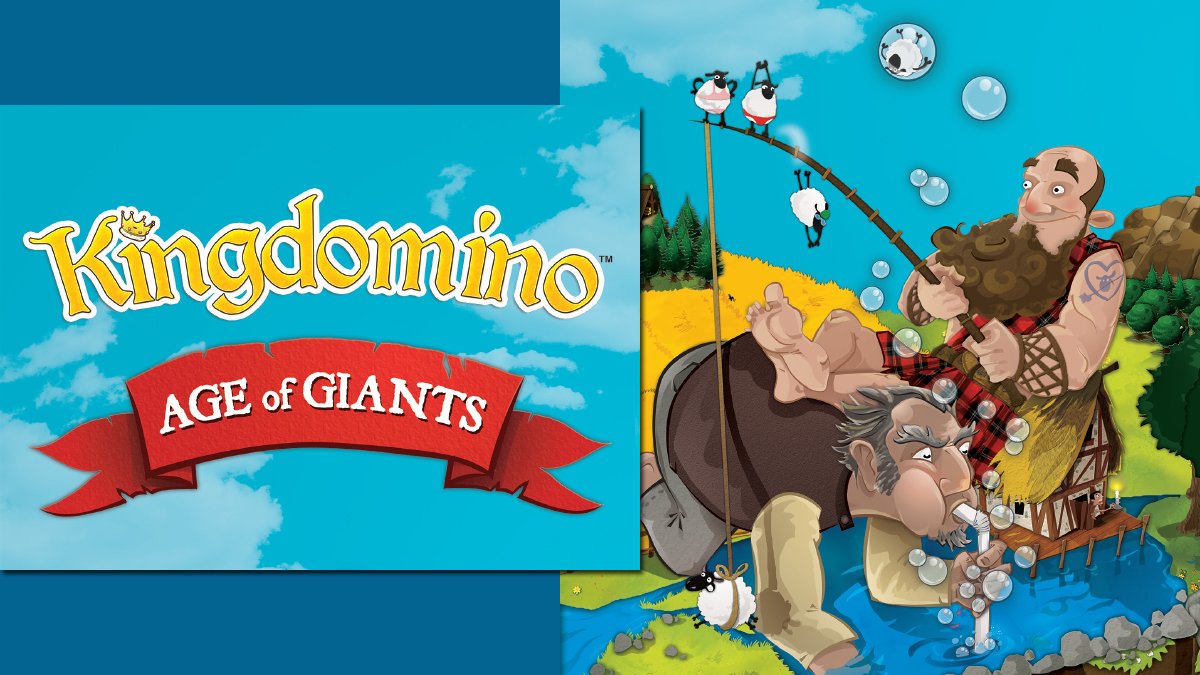
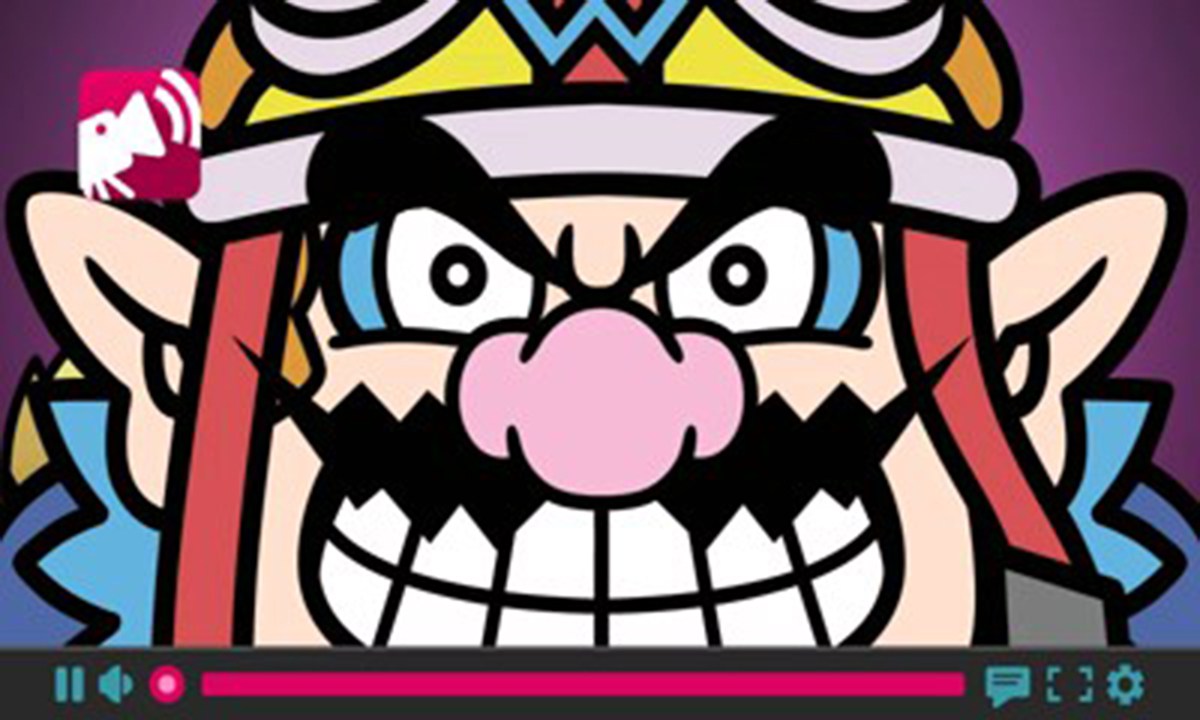
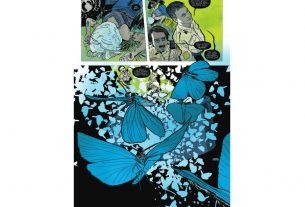
https://www.change.org/p/netflix-or-amazon-or-hulu-need-to-buy-rights-to-the-avatar-franchise-from-nickelodeon
Do you have any additional pictures of the technique cards? I’m curious how different the different cards are for different teams as well as the different levels of chi. Thanks.
Hi, Joe, I’ve added two photos near the bottom of the review showing some of the different technique cards for the two teams. The Wolfbats each have at least one card that could draw a yellow fan. The costs range from 1 to 5, at least in the cards I’ve seen. The swirly icon on the Woflbats cards are their “Daze” power, and the comet-like icon on the Fire Ferrets cards are their “Counterbend” power.
Thanks a lot Jonathan! I backed the game on Kickstarter and though I’ve seen a lot of gameplay videos I was never really able to see how different the cards were!
You’re welcome! I noticed after your comment that they showed a lot of the trick cards, but not the technique cards from all of the different teams. I like that not only do the teams feel different from each other, but the benders within a team are also different and have varying approaches.